英语中定语和状语的区别
- 格式:doc
- 大小:17.00 KB
- 文档页数:1
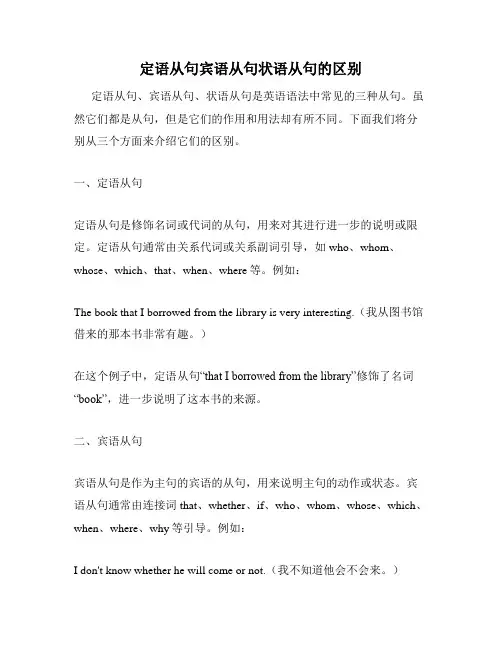
定语从句宾语从句状语从句的区别定语从句、宾语从句、状语从句是英语语法中常见的三种从句。
虽然它们都是从句,但是它们的作用和用法却有所不同。
下面我们将分别从三个方面来介绍它们的区别。
一、定语从句定语从句是修饰名词或代词的从句,用来对其进行进一步的说明或限定。
定语从句通常由关系代词或关系副词引导,如who、whom、whose、which、that、when、where等。
例如:The book that I borrowed from the library is very interesting.(我从图书馆借来的那本书非常有趣。
)在这个例子中,定语从句“that I borrowed from the library”修饰了名词“book”,进一步说明了这本书的来源。
二、宾语从句宾语从句是作为主句的宾语的从句,用来说明主句的动作或状态。
宾语从句通常由连接词that、whether、if、who、whom、whose、which、when、where、why等引导。
例如:I don't know whether he will come or not.(我不知道他会不会来。
)在这个例子中,宾语从句“whether he will come or not”作为主句的宾语,说明了主句的不确定性。
三、状语从句状语从句是用来修饰主句中的动作或状态的从句,通常由连接词if、when、while、although、because、since、as、unless等引导。
例如:Although it was raining heavily, he still went out for a walk.(尽管下着大雨,他还是出去散步了。
)在这个例子中,状语从句“Although it was raining heavily”修饰了主句中的动作“he still went out for a walk”,说明了他的行为与外界环境的不协调性。
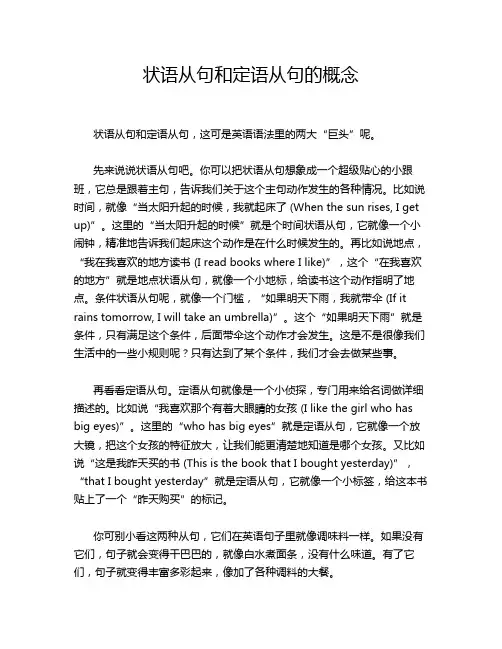
状语从句和定语从句的概念状语从句和定语从句,这可是英语语法里的两大“巨头”呢。
先来说说状语从句吧。
你可以把状语从句想象成一个超级贴心的小跟班,它总是跟着主句,告诉我们关于这个主句动作发生的各种情况。
比如说时间,就像“当太阳升起的时候,我就起床了 (When the sun rises, I get up)”。
这里的“当太阳升起的时候”就是个时间状语从句,它就像一个小闹钟,精准地告诉我们起床这个动作是在什么时候发生的。
再比如说地点,“我在我喜欢的地方读书 (I read books where I l ike)”,这个“在我喜欢的地方”就是地点状语从句,就像一个小地标,给读书这个动作指明了地点。
条件状语从句呢,就像一个门槛,“如果明天下雨,我就带伞 (If it rains tomorrow, I will take an umbrella)”。
这个“如果明天下雨”就是条件,只有满足这个条件,后面带伞这个动作才会发生。
这是不是很像我们生活中的一些小规则呢?只有达到了某个条件,我们才会去做某些事。
再看看定语从句。
定语从句就像是一个小侦探,专门用来给名词做详细描述的。
比如说“我喜欢那个有着大眼睛的女孩 (I like the girl who has big eyes)”。
这里的“who has big eyes”就是定语从句,它就像一个放大镜,把这个女孩的特征放大,让我们能更清楚地知道是哪个女孩。
又比如说“这是我昨天买的书(This is the book that I bought yesterday)”,“that I bought yesterday”就是定语从句,它就像一个小标签,给这本书贴上了一个“昨天购买”的标记。
你可别小看这两种从句,它们在英语句子里就像调味料一样。
如果没有它们,句子就会变得干巴巴的,就像白水煮面条,没有什么味道。
有了它们,句子就变得丰富多彩起来,像加了各种调料的大餐。
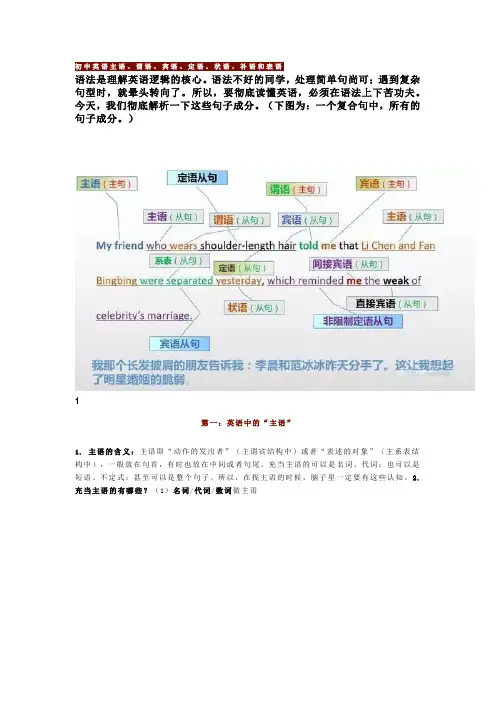
初中英语主语、谓语、宾语、定语、状语、补语和表语语法是理解英语逻辑的核心。
语法不好的同学,处理简单句尚可;遇到复杂句型时,就晕头转向了。
所以,要彻底读懂英语,必须在语法上下苦功夫。
今天,我们彻底解析一下这些句子成分。
(下图为:一个复合句中,所有的句子成分。
)1第一:英语中的“主语”1. 主语的含义:主语即“动作的发出者”(主谓宾结构中)或者“表述的对象”(主系表结构中),一般放在句首,有时也放在中间或者句尾。
充当主语的可以是名词、代词;也可以是短语、不定式;甚至可以是整个句子。
所以,在找主语的时候,脑子里一定要有这些认知。
2. 充当主语的有哪些?(1)名词/代词/数词做主语(2)不定式/名词化短语做主语(3)从句做主语(即主语从句)从句做主语的句子,就是我们学过的“主语从句”。
主语从句可以由连词that/whether引导;也可以由关系代词what/who/which引导;还可以由连接副词how/when/why/where引导。
详情如下:(4)有时为了避免头重脚轻,经常会借助“it”充当形式主语,而真正的主语则放在句尾:(5)“There be …”句型“there be…”比较特殊。
在这种句型中,主语的位置在中间。
比如:There are six beautiful French ladies walking on the street.大街上有六位漂亮的法国女郎在散步。
2第二:英语中的“谓语”1. 含义:谓语是句子的灵魂,主要用来“陈述主语的状态”或者“表明主语发出的动作”。
2. 分类:简单谓语复合谓语(1)简单谓语:由一个动词或者一个动词短语构成谓语;I lovemy girlfriend.我爱我的女朋友。
My boss stayed up late last night. 我的老板昨晚熬夜了。
(2)复合谓语:①情态动词/助动词+动词构成②系动词+表语构成③情态动词+系动词:3第三:英语中的“宾语”含义:宾语与主语相对,表示动作的承受者。
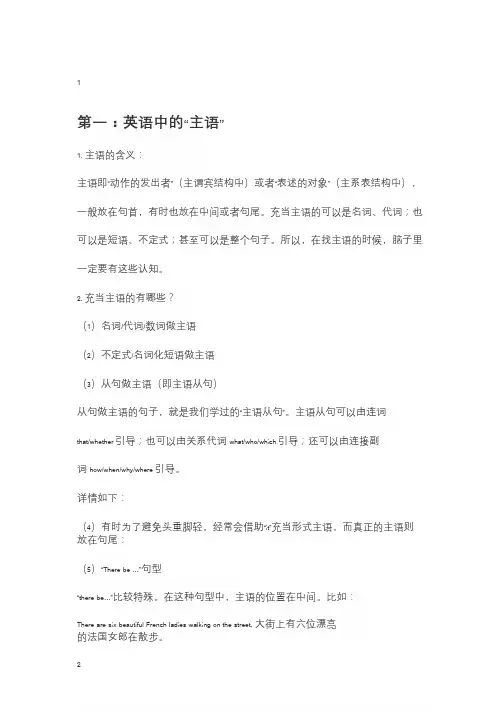
1第一:英语中的“主语”1. 主语的含义:主语即“动作的发出者”(主谓宾结构中)或者“表述的对象”(主系表结构中),一般放在句首,有时也放在中间或者句尾。
充当主语的可以是名词、代词;也可以是短语、不定式;甚至可以是整个句子。
所以,在找主语的时候,脑子里一定要有这些认知。
2. 充当主语的有哪些?(1)名词/代词/数词做主语(2)不定式/名词化短语做主语(3)从句做主语(即主语从句)从句做主语的句子,就是我们学过的“主语从句”。
主语从句可以由连词that/whether引导;也可以由关系代词what/who/which引导;还可以由连接副词how/when/why/where引导。
详情如下:(4)有时为了避免头重脚轻,经常会借助“it”充当形式主语,而真正的主语则放在句尾:(5)“There be …”句型“there be…”比较特殊。
在这种句型中,主语的位置在中间。
比如:There are six beautiful French ladies walking on the street. 大街上有六位漂亮的法国女郎在散步。
2第二:英语中的“谓语”1. 含义:谓语是句子的灵魂,主要用来“陈述主语的状态”或者“表明主语发出的动作”。
2. 分类:简单谓语复合谓语(1)简单谓语:由一个动词或者一个动词短语构成谓语;I love my girlfriend. 我爱我的女朋友。
My boss stayed up late last night. 我的老板昨晚熬夜了。
(2)复合谓语:①情态动词/助动词+动词构成②系动词+表语构成③情态动词+系动词:3第三:英语中的“宾语”含义:宾语与主语相对,表示动作的承受者。
名词、代词、数词以及句子都可以做宾语(宾语从句)。
(1)直接宾语&间接宾语/代词做宾语/名词做宾语(2)数词/从句做宾语4第四:英语中的“定语”“定语”顾名思义就是为了限定句中某个的成分。
形容词、数词、代词、从句(定语从句)等成分基本都可以做定语(动词除外)。
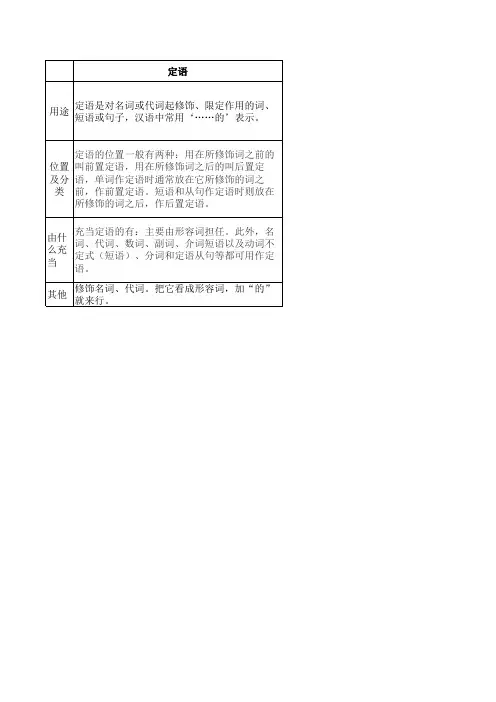
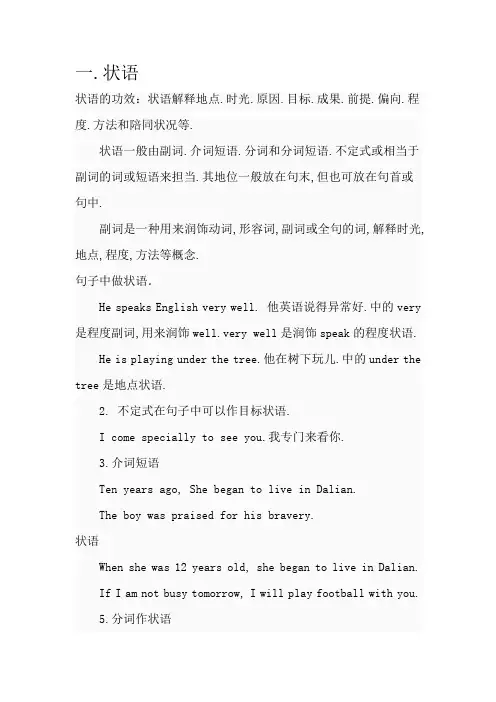
一.状语状语的功效:状语解释地点.时光.原因.目标.成果.前提.偏向.程度.方法和陪同状况等.状语一般由副词.介词短语.分词和分词短语.不定式或相当于副词的词或短语来担当.其地位一般放在句末,但也可放在句首或句中.副词是一种用来润饰动词,形容词,副词或全句的词,解释时光,地点,程度,方法等概念.句子中做状语.He speaks English very well. 他英语说得异常好.中的very 是程度副词,用来润饰well.very well是润饰speak的程度状语.He is playing under the tree.他在树下玩儿.中的under the tree是地点状语.2. 不定式在句子中可以作目标状语.I come specially to see you.我专门来看你.3.介词短语Ten years ago, She began to live in Dalian.The boy was praised for his bravery.状语When she was 12 years old, she began to live in Dalian.If I am not busy tomorrow, I will play football with you.5.分词作状语Having had a quarrel with his wife, he left home in a bad temper.Inhibited in one direction, it now seems that the Mississippi is about to take another.6.词组作状语She jumped ten feet. 她跳了十英尺远.二.表语在情势上,位于系动词后的就是表语.从寄义上讲,表语是答复主语“是什么”或“怎么样”的语法成分.等于指“是”字句“是”字后面的成分.表语就是起表述感化的句子成分.它润饰的是主语.表语是用来解释主语的身份.性质.品性.特点和状况的.表语须和连络动词一路组成句子的复合谓语.表语常由名词.形容词.副词.介词短语.不定式.动词的-ing.从句来充当,它常位于连络动词(be, become, appear, seem等)之后.物理学家.三.宾语宾语,又称受词,是指一个动作(动词)的接收者.宾语分为直接宾语和间接宾语两大类,个中直接宾语指动作的直接对象,间接宾语解释动作的非直接,但受动作影响的对象.一般而言,及物动词后面起码要有一个宾语,而该宾语平日为直接宾语,有些及物动词请求两个宾语,则这两个宾语平日一个为直接宾语,另一个为间接宾语.用法Show me(间接宾语)your tickets(直接宾语),please.宾语一般用在及物动词的后面,暗示行动动词所涉及的对象.一. 名词作宾语Show your passport, please. 请出示护照.二. 代词作宾语She didn't say anything. 她什么也没说.三. 数词作宾语How many do you want? — I want two. 你要几个?-我要两个.四. 名词化的形容词作宾语They sent the injured to hospital. 他们把伤员送到病院.五. 不定式或ing情势作宾语They asked to see my passport. 他们请求看我的护照.I enjoy working with you. 我和你们一道工作很高兴.六. 从句作宾语Did you write down what he said? 你把他的话写下了没有?四.补语英语补语的感化对象是主语和宾语,具有光鲜的定语性描述或限制性功效,在句法上是不成或缺的.补语是起填补解释感化的成份.最罕有的是宾语补足语.名词.动名词.形容词.副词.不定式.如今分词.曩昔分词都可以在句子中作宾补.补语是述补构造中填补解释述语的成果.程度.趋势.可能.状况.数目等的成分.补语与述语之间是填补与被填补.解释与被解释的关系.比方说,beat him dead ,把他打逝世,dead在这句话里就是充当补语成分,填补解释打的成果或者说打的程度是——逝世了,别的进修英语的时刻别逝世扣语法,多读多背,有语感之后你就能慢慢分辩出它是什么成分了,,再举个例子 kiss me again再亲我一下, again是暗示数目的补语!一.主语的补语:它用在系动词后,是句子的一个根本成分.经常应用主-系-表构造.1.I saw her with them, at least, I thought it was her. 我看到她和他们在一路,至少,至少我以为是她.(her做宾语,them做介词宾语,her做主语补语)2.. -- Who broke the vase? --谁打碎了花瓶?-- Me. --我. (me做主语补语= It's me.)3.John hoped the passenger would be Mary and indeed it was she. (she做主语补语)约翰愿望那位乘客是玛丽,还真是她.二.宾语的补语1.不定式(to do)Father will not allow us to play on the street. 父亲不让我们在街上玩耍.We believe him to be guilty. 我们信任他是有罪的.We made him copy the sentence.He is made to copy the sentence.I felt my hands tremble.2.名词At the meeting we elected him monitor.I think your brother a clever boy.3.形容词What you said made Xiao Wang angry.I found the classroom empty4.副词Please call the students back at once.He was seen to take his cap off.5.如今分词We hear him singing in the hall.I found him lying in bed, sleeping.6.曩昔分词He saw his face reflected in the water.I heard it spoken of in the next room.五.定语定语是用来润饰.限制.解释名词或代词的品德与特点的. 重要有形容词此外还著名词.代词.数词.介词短语.动词不定式(短语).分词.定语从句或相当于形容词的词.短语或句子都可以作定语.汉语中经常应用‘……的’暗示.定语和中间语之间是润饰和被润饰.限制和被限制的关系.在汉语中,中间语与定语二者之间有的须要用构造助词“的”,有的不须要,有的可要可不要. “的”是定语的标记.介词短语作定语The boy in the classroom needs a pen of yours.(in the classroom 润饰名词boy;of yours润饰名词pen)/教室里的男孩须要你的一支钢笔.The boy in blue is Tom.(in blue润饰名词boy)/穿蓝色衣服的孩子是汤姆.There are two boys of 9,and three of 10.(two,three,of 9和of10润饰名词boy)/有两个9岁的,三个10岁的男孩.名词作定语The boy needs a ball pen.(ball润饰名词pen)/男孩须要一支圆珠笔.It is a ball pen.(ball润饰名词pen)/这是一支圆珠笔.There is only one ball pen in the pencil box.(the pencil box润饰名词ball pen )/这铅笔盒里只有一支圆珠笔.副词作定语The boy there needs a pen.(there润饰名词boy)/那儿的男孩须要一支钢笔.The best boy here is Tom.(here润饰名词boy)/这里最棒的男孩是Tom.不定式作定语The boy to write this letter needs a pen.( to write this letter 润饰名词boy)/写这封信的男孩须要一支钢笔.The boy to write this letter is Tom.(to write this letter 润饰名词boy)/将要写这封信的男孩是汤姆.There is nothing to do today.(to do 润饰名词nothing)/今天没有事要做.分词(短语)作定语The smiling boy needs a pen bought by his mother.( smiling 润饰名词boy;bought by his mother润饰名词pen)/谁人微笑的男孩须要一支他妈妈买的钢笔.The pen bought by her is made in China.(bought by her 润饰名词pen;bought by her 润饰名词pen)/她买的笔是中国产的.There are five boys left.(five润饰名词boy;left润饰名词boy)/有五个留下的男孩.六.主语主语是履行句子的行动或动作的主体,如“我写字”中的“我”,就是主语,它做出“写”这个动作.“写”则是谓语,而“字”是接收谓语“写”这个动作的对象,它是以被称为宾语,有的语法书也称它为“客体”或“受体”.主语可以这些列词类或情势来担任:名词,代词,名词化了的动词,形容词,分词,副词或数词等,动词不定式或不定式短语,从句,某些固定词组的第二格.作主语的词:名词,代词,名词化了的动词,形容词,分词,副词或数词等,动词不定式或不定式短语, 从句,某些固定词组的第二格.1. 名词作主语直到河里的鱼逝世了,村平易近们才意识到污染的伤害.The villagers didn't realize how serious the pollution was until the fish in the river died.S+ V t +O. 主系表构造 :S+V倒装:Not until the fish in the river died did the villagers realize how serious the pollution was.留意:倒装在主句,从句不倒装 /did 和not 提前,只剩动词本相强调:It was not until the fish died in the river that the villagers realized how serious the pollution was.假如强调的是主语或宾语且指人用who,其他一律用that.是that,而非其他/主句的次序((倒装不强调,强调就不倒装))人称代词(主格),名词性代词,指导代词,不定代词,such(----样的人.物),it(时光,气象,距离等)at midnight /in the(泛指)middle of the nightIt is 9 o'clock when I went home.It was ten when I got home.一般句It was at ten that I got home.强调句I got home at ten.本相注释:作主语在句首/it作主语组成(经常应用 v-ing,不经常应用只有 use,good)It is +adj. +of sb.(人的属性)/for sb.(物的属性)to do It is necessary to finish the design before National day. Tomorrow is National day.it is +n.+for/of sb. to doIt is not good manners for Arabs to stand close talking to their friends.It is a great honor for us to be invited to the party.在感慨句中必须用it作情势主语:What a joy/ pleasure (it is) to read the book.在问句中必须用情势主语:Is it possible to go to the moon by spaceship?Ten out of 100 Americans are over /above /more than 65.一般 / 完成时v-ing: 自动/doing/having donenot doing:自动/being done/having done留意:doing 无时光限制/与谓语同时消失/在谓语动词后产生having done产生在谓语之前He still remembers being prized.当逻辑主语为无性命的器械时a.作主语时,平日暗示一般性的无时光性的器械.而不定式暗示某一种具体的动作.Smoking is hobbit difficult to break.表语一致Seeing is believing.c.逻辑主语必须是所有格情势Smoking kills.d. it 作情势主语:It is no use/good-----The old man's taking pity on the snake leads to his death.谁人老头恻隐那条蛇,导致他的逝世亡.To +动词本相Not to do 解释:具有动词的性质,作宾语,状语/具著名词的性质,作主语/具有形容词性质,作定语/具有副词的性质,作状语.除谓语不成作之外,其他都可.一般式:to do进行时:to be doing完成时:to have done完成进行时:to have been doingto do:暗示动作产生在谓语之后,I want to go home.与谓语动词几乎同时产生to be doing :暗示与谓语动词同时产生to have done:产生在谓语动词之前 Someone was considered to have done something.to have been doing :动作从曩昔开端一向中断到谓语动词这个动作的产生不定式暗示一种肯定的动作To do morning exercises this morning is not good for your healthy.the poor / the disabled /the sickFrom my home to school is three kilometers.副词----不定式或动名词What an excitement to find a shark when you’re swimming in the sea.。
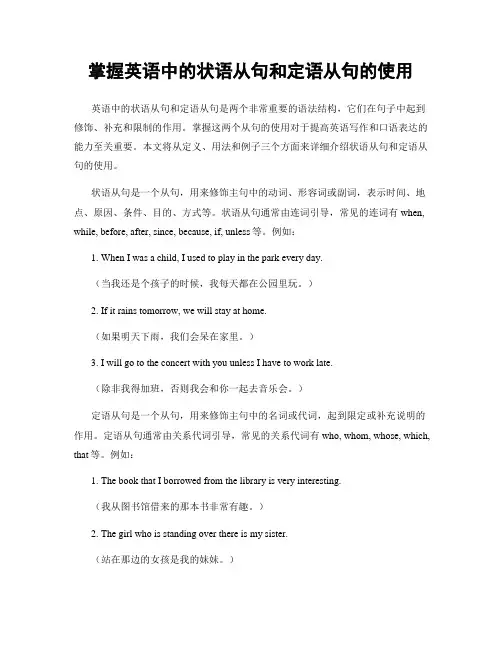
掌握英语中的状语从句和定语从句的使用英语中的状语从句和定语从句是两个非常重要的语法结构,它们在句子中起到修饰、补充和限制的作用。
掌握这两个从句的使用对于提高英语写作和口语表达的能力至关重要。
本文将从定义、用法和例子三个方面来详细介绍状语从句和定语从句的使用。
状语从句是一个从句,用来修饰主句中的动词、形容词或副词,表示时间、地点、原因、条件、目的、方式等。
状语从句通常由连词引导,常见的连词有when, while, before, after, since, because, if, unless等。
例如:1. When I was a child, I used to play in the park every day.(当我还是个孩子的时候,我每天都在公园里玩。
)2. If it rains tomorrow, we will stay at home.(如果明天下雨,我们会呆在家里。
)3. I will go to the concert with you unless I have to work late.(除非我得加班,否则我会和你一起去音乐会。
)定语从句是一个从句,用来修饰主句中的名词或代词,起到限定或补充说明的作用。
定语从句通常由关系代词引导,常见的关系代词有who, whom, whose, which, that等。
例如:1. The book that I borrowed from the library is very interesting.(我从图书馆借来的那本书非常有趣。
)2. The girl who is standing over there is my sister.(站在那边的女孩是我的妹妹。
)3. This is the house where I used to live.(这是我曾经住过的房子。
)状语从句和定语从句的使用需要注意以下几点:首先,要注意连词的选择。
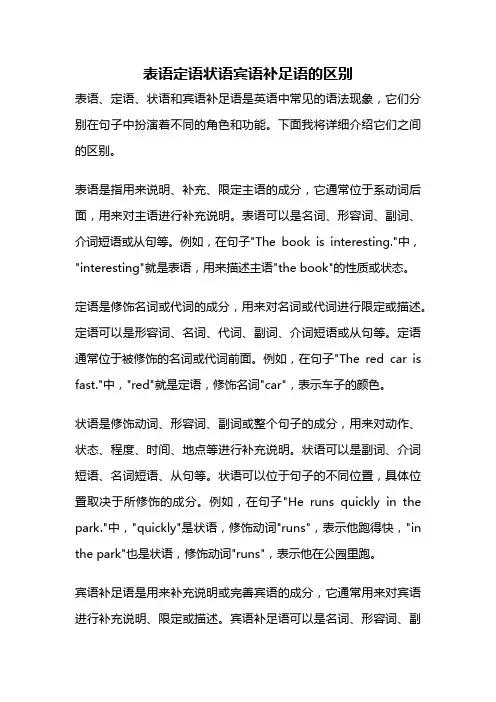
表语定语状语宾语补足语的区别表语、定语、状语和宾语补足语是英语中常见的语法现象,它们分别在句子中扮演着不同的角色和功能。
下面我将详细介绍它们之间的区别。
表语是指用来说明、补充、限定主语的成分,它通常位于系动词后面,用来对主语进行补充说明。
表语可以是名词、形容词、副词、介词短语或从句等。
例如,在句子"The book is interesting."中,"interesting"就是表语,用来描述主语"the book"的性质或状态。
定语是修饰名词或代词的成分,用来对名词或代词进行限定或描述。
定语可以是形容词、名词、代词、副词、介词短语或从句等。
定语通常位于被修饰的名词或代词前面。
例如,在句子"The red car is fast."中,"red"就是定语,修饰名词"car",表示车子的颜色。
状语是修饰动词、形容词、副词或整个句子的成分,用来对动作、状态、程度、时间、地点等进行补充说明。
状语可以是副词、介词短语、名词短语、从句等。
状语可以位于句子的不同位置,具体位置取决于所修饰的成分。
例如,在句子"He runs quickly in the park."中,"quickly"是状语,修饰动词"runs",表示他跑得快,"in the park"也是状语,修饰动词"runs",表示他在公园里跑。
宾语补足语是用来补充说明或完善宾语的成分,它通常用来对宾语进行补充说明、限定或描述。
宾语补足语可以是名词、形容词、副词、介词短语或从句等。
宾语补足语通常位于及物动词或使役动词后面,用来对动作的结果或影响进行补充说明。
例如,在句子"I find the book interesting."中,"interesting"是宾语补足语,补充说明了宾语"the book"的性质或状态。
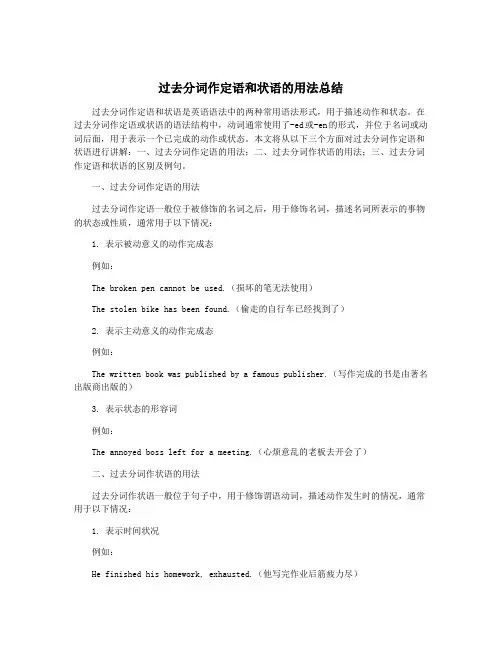
过去分词作定语和状语的用法总结过去分词作定语和状语是英语语法中的两种常用语法形式,用于描述动作和状态。
在过去分词作定语或状语的语法结构中,动词通常使用了-ed或-en的形式,并位于名词或动词后面,用于表示一个已完成的动作或状态。
本文将从以下三个方面对过去分词作定语和状语进行讲解:一、过去分词作定语的用法;二、过去分词作状语的用法;三、过去分词作定语和状语的区别及例句。
一、过去分词作定语的用法过去分词作定语一般位于被修饰的名词之后,用于修饰名词,描述名词所表示的事物的状态或性质,通常用于以下情况:1. 表示被动意义的动作完成态例如:The broken pen cannot be used.(损坏的笔无法使用)The stolen bike has been found.(偷走的自行车已经找到了)2. 表示主动意义的动作完成态例如:The written book was published by a famous publisher.(写作完成的书是由著名出版商出版的)3. 表示状态的形容词例如:The annoyed boss left for a meeting.(心烦意乱的老板去开会了)二、过去分词作状语的用法过去分词作状语一般位于句子中,用于修饰谓语动词,描述动作发生时的情况,通常用于以下情况:1. 表示时间状况例如:He finished his homework, exhausted.(他写完作业后筋疲力尽)She stood there, frozen with fear.(她站在那里,惊恐万分)2. 表示原因或结果例如:Having saved enough money, he bought a new car.(存够了钱,他买了一辆新车)Being late for the meeting, they missed their chance.(因为迟到,他们错过了机会。
)3. 表示条件状况例如:Having finished the task, he went home.(完成任务后,他回家了)三、过去分词作定语和状语的区别及例句过去分词作定语和状语的最大区别在于它们所修饰的词不同。
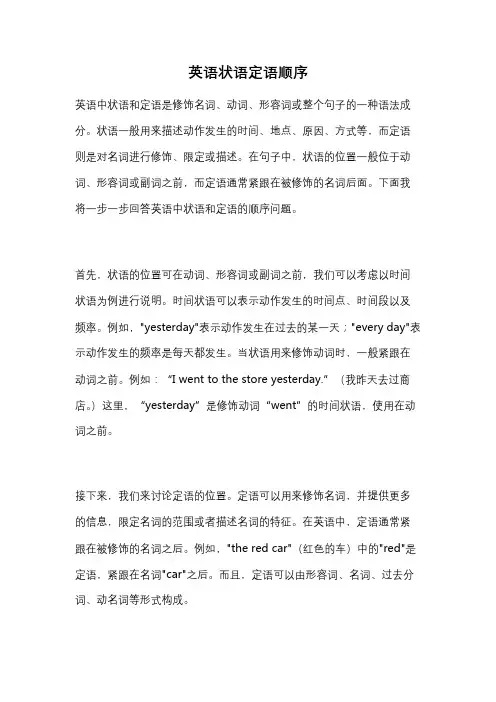
英语状语定语顺序英语中状语和定语是修饰名词、动词、形容词或整个句子的一种语法成分。
状语一般用来描述动作发生的时间、地点、原因、方式等,而定语则是对名词进行修饰、限定或描述。
在句子中,状语的位置一般位于动词、形容词或副词之前,而定语通常紧跟在被修饰的名词后面。
下面我将一步一步回答英语中状语和定语的顺序问题。
首先,状语的位置可在动词、形容词或副词之前,我们可以考虑以时间状语为例进行说明。
时间状语可以表示动作发生的时间点、时间段以及频率。
例如,"yesterday"表示动作发生在过去的某一天;"every day"表示动作发生的频率是每天都发生。
当状语用来修饰动词时,一般紧跟在动词之前。
例如:“I went to the store yesterday.”(我昨天去过商店。
)这里,“yesterday”是修饰动词“went”的时间状语,使用在动词之前。
接下来,我们来讨论定语的位置。
定语可以用来修饰名词,并提供更多的信息,限定名词的范围或者描述名词的特征。
在英语中,定语通常紧跟在被修饰的名词之后。
例如,"the red car"(红色的车)中的"red"是定语,紧跟在名词"car"之后。
而且,定语可以由形容词、名词、过去分词、动名词等形式构成。
然而,状语和定语在句子中的位置是可以变化的。
虽然一般而言,状语位于动词、形容词或副词之前,而定语紧跟在被修饰的名词后面,但这并不是绝对的。
根据需要和强调的程度,这两者的位置可以发生变化。
让我们举一个例子说明这种变化。
考虑以下句子:"The woman in the blue dress walked slowly."(那个穿着蓝色连衣裙的女人走得很慢。
)在这个例子中,我们有两个定语和一个状语。
定语"the blue dress"紧跟在名词"woman"之后,描述了这个女人穿着什么样的连衣裙。
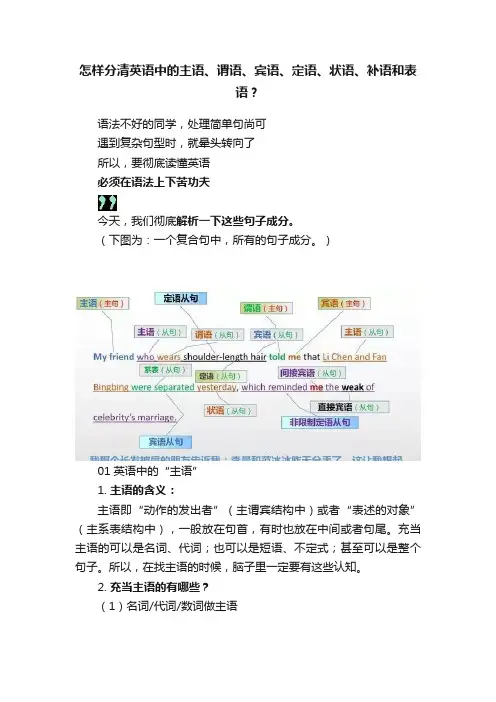
怎样分清英语中的主语、谓语、宾语、定语、状语、补语和表语?语法不好的同学,处理简单句尚可遇到复杂句型时,就晕头转向了所以,要彻底读懂英语必须在语法上下苦功夫今天,我们彻底解析一下这些句子成分。
(下图为:一个复合句中,所有的句子成分。
)01英语中的“主语”1. 主语的含义:主语即“动作的发出者”(主谓宾结构中)或者“表述的对象”(主系表结构中),一般放在句首,有时也放在中间或者句尾。
充当主语的可以是名词、代词;也可以是短语、不定式;甚至可以是整个句子。
所以,在找主语的时候,脑子里一定要有这些认知。
2. 充当主语的有哪些?(1)名词/代词/数词做主语(2)不定式/名词化短语做主语(3)从句做主语(即主语从句)从句做主语的句子,就是我们学过的“主语从句”。
主语从句可以由连词that/whether引导;也可以由关系代词what/who/which 引导;还可以由连接副词how/when/why/where引导。
详情如下:(4)有时为了避免头重脚轻,经常会借助“it”充当形式主语,而真正的主语则放在句尾:(5)“There be …”句型“there be…”比较特殊。
在这种句型中,主语的位置在中间。
比如:There are six beautiful French ladies walking on the street.大街上有六位漂亮的法国女郎在散步。
02英语中的“谓语”1. 含义:谓语是句子的灵魂,主要用来“陈述主语的状态”或者“表明主语发出的动作”。
2. 分类:简单谓语复合谓语(1)简单谓语:由一个动词或者一个动词短语构成谓语;I love my girlfriend.我爱我的女朋友。
My boss stayed up late last night.我的老板昨晚熬夜了。
(2)复合谓语:① 情态动词/助动词动词构成② 系动词表语构成③ 情态动词系动词:03英语中的“宾语”含义:宾语与主语相对,表示动作的承受者。
第一:英语中的“主语”1. 主语的含义:主语即“动作的发出者”(主谓宾结构中)或者“表述的对象”(主系表结构中),一般放在句首,有时也放在中间或者句尾。
充当主语的可以是名词、代词;也可以是短语、不定式;甚至可以是整个句子。
所以,在找主语的时候,脑子里一定要有这些认知。
2. 充当主语的有哪些?(1)名词/代词/数词做主语(2)不定式/名词化短语做主语(3)从句做主语(即主语从句)从句做主语的句子,就是我们学过的“主语从句”。
主语从句可以由连词that/whether引导;也可以由关系代词what/who/which引导;还可以由连接副词how/when/why/where引导。
详情如下:(4)有时为了避免头重脚轻,经常会借助“it”充当形式主语,而真正的主语则放在句尾:(5)“There be …”句型“there be…”比较特殊。
在这种句型中,主语的位置在中间。
比如:There are six beautiful French ladies walking on the street.大街上有六位漂亮的法国女郎在散步。
2第二:英语中的“谓语”1. 含义:谓语是句子的灵魂,主要用来“陈述主语的状态”或者“表明主语发出的动作”。
2. 分类:简单谓语复合谓语(1)简单谓语:由一个动词或者一个动词短语构成谓语;I love my girlfriend.我爱我的女朋友。
My boss stayed up late last night.我的老板昨晚熬夜了。
(2)复合谓语:① 情态动词/助动词+动词构成② 系动词+表语构成③ 情态动词+系动词:3第三:英语中的“宾语”含义:宾语与主语相对,表示动作的承受者。
名词、代词、数词以及句子都可以做宾语(宾语从句)。
(1)直接宾语&间接宾语/代词做宾语/名词做宾语(2)数词/从句做宾语4第四:英语中的“定语”“定语”顾名思义就是为了限定句中某个的成分。
形容词、数词、代词、从句(定语从句)等成分基本都可以做定语(动词除外)。
怎么区分不定式做目的定语或状语在英语语法中,不定式可以作为定语或状语。
定语不定式修饰名词或代词,而状语不定式修饰动词、形容词、副词或整个句子。
当初学英语的时候,很容易搞混两者的用法,因为它们的构造形式很相似,都是由“to + 动词原形”组成。
但是,它们的作用却有很大的区别。
以下是一些区分不定式作为目的定语或状语的方法:1. 位置:不定式作为状语通常位于谓语动词之后,而不定式作为定语则位于被修饰的名词或代词之后。
例如:- I need a book to read tonight.(这里的不定式作为定语,修饰名词“book”,说明是什么样的书)- I went to the library to read a book.(这里的不定式作为状语,说明动作“去图书馆”是为了做什么,修饰整个句子)2. 意义:不定式作为定语时,它要么表示被修饰的名词或代词的用途、目的或特征,要么表示后面的名词或代词所需要的条件。
不定式作为状语,它通常表示一个目的、结果、原因等等。
例如:- She needs a pen to write with.(这里的不定式作为定语,说明她需要什么样的笔)- She went to the store to buy a pen.(这里的不定式作为状语,说明她去商店的目的是为了买笔)3. 可否省略:作为定语的不定式通常不能省略,因为它们对于句子的含义非常关键。
而作为状语的不定式可以省略,因为它们只是对句子陈述的补充。
例如:- I have some work to do.(这里的不定式作为定语,不能省略,表示“我要做的工作”)- He came to my house to talk.(这里的不定式作为状语,可以省略,修饰动作“来我家”)4. 上下文:上下文对于理解不定式的作用是至关重要的。
有时候,一个不定式既可以作为定语又可以作为状语,它的作用取决于上下文的意义。
例如:- He has a lot of books to read.(这里的不定式作为定语)- He has a lot of work to do, so he can't come tonight.(这里的不定式作为状语)总的来说,区分不定式作为目的定语或状语需要注意它们在句子中的位置、意义、可否省略以及上下文的含义。
怎样分清英语中的主语、谓语、宾语、定语、状语、补语和表语?语法是理解英语逻辑的核心。
语法不好的同学,处理简单句尚可;遇到复杂句型时,就晕头转向了。
所以,要彻底读懂英语,必须在语法上下苦功夫。
今天,我们彻底解析一下这些句子成分。
(下图为:一个复合句中,所有的句子成分。
)1第一:英语中的“主语”1. 主语的含义:主语即“动作的发出者”(主谓宾结构中)或者“表述的对象”(主系表结构中),一般放在句首,有时也放在中间或者句尾。
充当主语的可以是名词、代词;也可以是短语、不定式;甚至可以是整个句子。
所以,在找主语的时候,脑子里一定要有这些认知。
2. 充当主语的有哪些?(1)名词/代词/数词做主语(2)不定式/名词化短语做主语(3)从句做主语(即主语从句)从句做主语的句子,就是我们学过的“主语从句”。
主语从句可以由连词that/whether引导;也可以由关系代词what/who/which引导;还可以由连接副词how/when/why/where引导。
详情如下:(4)有时为了避免头重脚轻,经常会借助“it”充当形式主语,而真正的主语则放在句尾:(5)“There be …”句型“there be…”比较特殊。
在这种句型中,主语的位置在中间。
比如:There are six beautiful French ladies walking on the street.大街上有六位漂亮的法国女郎在散步。
2第二:英语中的“谓语”1. 含义:谓语是句子的灵魂,主要用来“陈述主语的状态”或者“表明主语发出的动作”。
2. 分类:简单谓语复合谓语(1)简单谓语:由一个动词或者一个动词短语构成谓语;I love my girlfriend.我爱我的女朋友。
My boss stayed up late last night.我的老板昨晚熬夜了。
(2)复合谓语:①情态动词/助动词+动词构成②系动词+表语构成③情态动词+系动词:3第三:英语中的“宾语”含义:宾语与主语相对,表示动作的承受者。
2021考研英语大纲复习指导:状语从句与定语从句的区别2021考研英语大纲复习指导:状语从句与定语从句的区别长难句分析是考研英语高分的基础,而状语从句和定语从句是考研英语长难句中最常见的修饰语和附加成分。
今天,我们将重点比较研究生入学考试英语语法中状语从句和定语从句的差异。
首先,我们必须弄清楚这两个概念之间的区别:状语从句,本质上是将几个从句与连词连接起来,以表达从句之间的特定逻辑关系;定语从句是修饰名词、代词、从句或句子的修饰语。
让我们来看一下具体的比较:第一,引导时间状语从句和定语从句。
【解析】句子中when引导的是定语从句,修饰其先行词time。
所以不能翻译成“当?时”。
在招聘合格人才越来越困难的时候,能够消除招聘过程中难以维持的偏见的雇主具有明显的优势。
【例2】whileeventhemodestlyeducatedsoughtanelevatedtonewhentheyputpentopaperbeforethe 1960s,eventhemostwellregardedwritingsincethenhassoughttocapturespokenenglishon thepage.这个句子中的When是时间状语从句。
因为它之前没有时间的先例,所以它应该被理解为“何时”。
【参考译文】在20世纪60年代之前,当人们伏案写作时,即使受教育不多的人也追求一种高雅的风格,而从那之后,即使是令人景仰的文章作品也在追求一种口语风格。
二、where引导的地点状语从句与定语从句当where引导定语从句时,必须有一个名词在where之前表示位置的意思,即先行词。
但请注意,有时先行词和定语从句可能是分开的。
Where在引导位置状语从句时更灵活。
【例1】他是一名亚裔美国人,在一所他寻求权威的房子里,他避开了你的视线【解析】本句中where引导的是定语从句,修饰其先行词household。
作为一名亚裔美国人,他在这样一个环境中长大:他避免将权威人士视为相互尊重的标志。
小学英语中的定语和状语知识点在学习英语的过程中,理解和掌握定语和状语的用法是非常重要的。
定语和状语在句子中起着修饰和补充说明的作用,能够让句子更加准确和丰富。
定语的作用和用法定语是修饰名词或代词的成分,用来限定名词或代词的范围和特征。
在句子中通常位于被修饰的名词或代词之前,起到对名词或代词进行描绘、限定的作用。
例如:“abeautifulflower”中的”beautiful”就是定语,修饰了”flower”这个名词。
定语的种类和形式定语可以是形容词、代词、数词、名词等,用来对名词进行修饰。
在句子中,定语可以是单个词语,也可以是短语或从句。
学生们在学习定语时,需要注意定语与被修饰词之间的搭配和顺序。
状语的作用和用法状语是修饰动词、形容词、副词或整个句子的成分,用来说明动作的方式、时间、地点、原因等情况。
状语在句子中的位置比较灵活,可以放在句首、句中或句末,起到补充说明和修饰的作用。
例如:“Shesingsbeautifully”中的”beautifully”就是状语,修饰了动词”sings”。
状语的种类和形式状语可以是副词、介词短语、动词短语、不定式、分词等形式,用来修饰动词或整个句子。
状语的种类很多,包括时间状语、地点状语、方式状语、原因状语等,学生们需要通过实际练习加深理解和掌握不同类型的状语。
在学习小学英语时,掌握定语和状语的知识点是非常基础和重要的。
通过理解定语和状语的作用、种类和用法,可以帮助学生更准确地表达自己的意思,提升语言表达能力和写作水平。
老师们在教学中也应注重对定语和状语的讲解和练习,帮助学生夯实语法基础,提高英语学习效果。
英语中的主语谓语宾语定语状语是什么意思英语当中的句式成分。
主语是指人或者是事物。
谓语是说明主语的状态或者是动作。
宾语指及物动词的结果或者是对象。
定语是指修饰性词汇,状语是用来修饰动词或者是形容词。
主语可以作主语的成分有名词(如boy),主格代词(如you),动词不定式,动名词等。
主语一般在句首。
注意名词单数形式常和冠词不分家!谓语谓语由动词构成,是英语时态、语态变化的主角,一般在主语之后。
不及物动词(vi.)没有宾语,形成主谓结构,如:We come.宾语宾语位于及物动词之后,一般同主语构成一样,不同的是构成宾语的代词必须是‘代词宾格’,如:me,him,them等。
定语定语是对名词或代词起修饰、限定作用的词、短语或句子,汉语中常用‘……的’表示。
定语通常位于被修饰的成分前。
若修饰some,any,every,no构成的复合不定代词时,(如:something、nothing);或不定式、分词短语作定语、从句作定语时,则定语通常置后。
副词用作定语时须放在名词之后。
状语状语又称副词性成分。
状语一般是为谓语动词服务的,表示谓语动词发生的背景,说明地点、时间、原因、结果、目的、让步、条件、方向、程度、比较、方式和伴随状况等。
由于状语用来修饰谓语动词,因此具有副词词性。
状语一般由副词、介词短语、分词和分词短语、不定式等担当。
其位置一般放在句末,但也可放在句首或句中。
副词是一种用来修饰动词、形容词、副词或全句的词,说明时间、地点、程度、方式等概念。
补语英语补语的作用对象是主语和宾语,具有鲜明的定语性描写或限制功能,在句法上市不可或缺的。
补语是起补充说明作用的成分,最常见的是宾语补足语。
名词、动名词、形容词、副词、不定式、现在分词、过去分词都可以在句子中作宾语补足语。